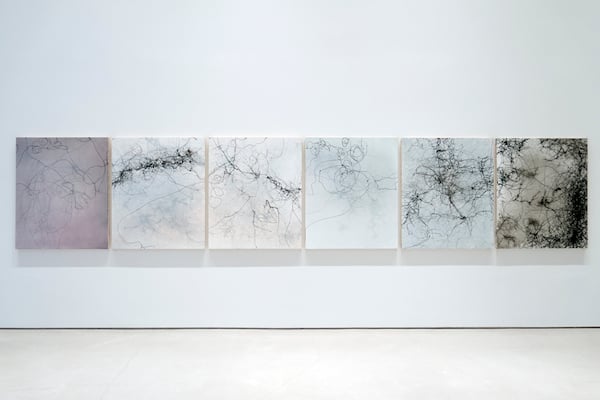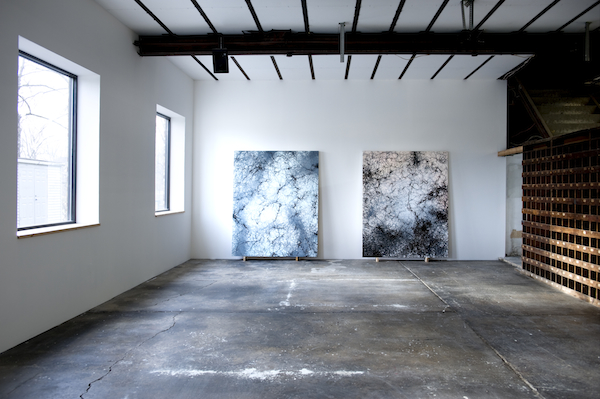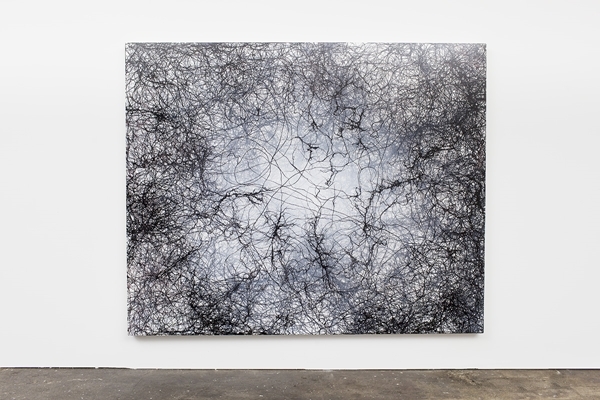
Emil Lukas, Liquid Reflector 1-6 (2013)
Photo: Courtesy Sperone Westwater, New York.
In case you missed it, the Farmers’ Almanac, which for 2013 correctly predicted a colder than usual New York winter, delivered a disquieting forecast for this summer. “Exceptionally hot” is the outlook for much of North America, with the Northeastern region of the country predicted to be “oppressively humid, wet, and thundery.”
For Emil Lukas, this may not be unwelcome news.
A sculptor and process painter who once divided his time between a Harlem studio and one in Stockertown, Pennsylvania, he now maintains two studios in the Keystone State, and in one of these he creates what he calls Larvae paintings.
The paintings are not representations of larvae, as you might think. In this case, the actual fly larvae of, say, Calliphora vomitoria, the blue bottle fly, behave as tools of his trade. They are what Lukas uses instead of conventional paintbrushes (not exactly Yves Klein’s “living brushes,” but hey).
It is February 22nd when I meet the artist at his downtown gallery, Sperone Westwater, on a bright Saturday morning. The Bowery neighborhood is on the march—to yoga, the nail salon, the Apple store, Falai. But in here, in this space, there is a slow heartbeat, thankfully.
This is the final day of Lukas’s solo exhibition, which opened on January 9th. On some walls hang his Thread paintings—works with colored polyester thread (physical, structural, pictorial lines) pulled over painted wood frames and “locked down” (as he puts it) on the edges. On other walls hang the Larvae paintings. It is these that hold my attention.
Lukas and I discuss the role that the weather plays. Consistently hot weather is essential to the work; it’s what motivates—literally—the insects during their residency at his Stockertown studio. The temperature determines the speed of what Lukas refers to as his two-month production season. During the doggy days—usually August and September—when the weather is the hottest, the larval life cycle is the most rapid.
Months before the larvae arrive, however, Lukas is hard at work, alone, during dark afternoons. Round about mid-February, he begins fashioning wood panels and stretching canvases. Then he adds many layers of gesso, applied and sanded many times, to approximate a surface as smooth as paper.
Come May (and crocuses), he’s applying acrylic paint and introducing color and composition. During these early days, Lukas estimates that he applies between 30 and 50 layers of paint using everything from rollers and all manner of fibrous brushes to splashing to spraying. He tints the primers, puts in lines or circles—to produce a set of compositionally unique “underpaintings.” One might be warm, another cool, another congested, another light. “I want the paintings to stand in relationship—I want the paintings to stand apart from one another as early as possible, before the larvae,” he explains.
And then, come late June or July, Father Nature sets his schedule, and Lukas is in his hands. The anticipation can be uncomfortable. Lukas says he asks himself a battery of questions: “Is it gonna be hot, is it gonna be cold? Is it gonna work? It is not gonna work? Is it gonna be a good week or a bad week? Am I going to paint this this week, or am I going to paint something else this week?”
Any day, Lukas must paint when the weather is hottest because a surprise cool front might always arrive unannounced. “It becomes a real drain by the end of summer,” he says. “It’s fantastic, but after a while, you definitely need a break. You don’t mind it being seasonal.”

Interior view of Emil Lukas’s studio barn.
Photo: Zach Hartzel, courtesy the artist and Sperone Westwater, New York.
How Lukas lures his blind collaborators is his own private, ugly secret about what he terms “the science” of the process. He won’t discuss that part.
“There’s no other insect that makes sense to connect these paintings to,” he says. “What larvae do, why and how they are—it’s the perfect connection.”
But come on, I say. Why flies?
“What I’m trying to achieve I feel can only be achieved this way, and it’s something that I’ve worked for 20 years to develop,” the artist states.
Twenty years? Actually, a few more than that.
One night during the late 1980s at his Harlem studio, Lukas casually murdered a pesky fly and left it overnight in a four-inch puddle of paint on a piece of cotton paper. The following day, much to his surprise, he returned to a drawing suggestive of a pattern of electricity or lightning. It turns out that his victim had been a life-bearing fly, carrying larvae, and the tiny life forms had tracked paint all over the paper.
Lukas was intrigued and began to conduct research and experiments with many organic materials, such as mold, seed germination, spore drops, carbon, and fat. Only flies (he has not worked with other insects) achieved the status of full-blown obsession and then: art.
Okay, but still: Why flies? (Personally I find them disgusting.)
“I’m after a mark that has intention,” Lukas tells me. “An intention then goes to rhythm, the rhythm goes to repetition, repetition starts to look like the human hand.”
Now I’m beginning to understand.
He continues: “There’s a formula that is very difficult to find when it comes to this intention, the human brain, and patterns. This is a link to a device”—the device being the fly larvae—“that allows me to work in a very clear and deliberate intention without the pattern subscribed by the human brain.”
Of course, Lukas sets countless parameters of play—including lighting (natural, artificial, direct, diffused—the larval visual system reacts to all of these), vibration level (the paintings are on wheels), density of color (Lukas uses a mixture of ink and paint, both water soluble), and the level of wetness of the canvas itself.
The process allows him “to direct a painting that has millions of lines, and the lines don’t fall into the pattern that a human would have if a human made a painting with millions of lines. That’s one of the things I really love about the paintings.”
I suppose I must love that too. I lean in towards one, then out. It’s wider than I am tall. A wiggly line reminds me of a river seen from 35,000 feet in the air. Hm. Now I inspect a coil. Could a human brain produce that design?
Lukas describes how he intervenes at one moment of the flies’ life cycle to get this effect. “From the time they are larvae until the time they pupate, I intervene at this little interval,” he says. “We make these paintings, and then the larvae are outside again; they hatch, they fly away—they fly all over the community. There’s something that’s very significant to me. There’s a moment they come in, there’s a moment they go out; and this is what we make.”
He and I pause, we human-brained beings, and look at each other.

Emil Lukas, Rain (2013)
Photo: Courtesy Sperone Westwater, New York.
One painting, called Rain, has an underpainting of cloudy-day white; the foreground is a brambly tangle.
“I want people to look at the paintings, and I want them to think about them like calligraphy or like lightning or roots or the history of painting being applied to a canvas in the many ways that other artists have done it,” he says.
But none of this occurs to me. Thoughts are not formulating. Instead, I begin to peer into the abundance of tangle. The mind-feel (for lack of a better phrase) of a small child in the woods comes over me. Somewhere beyond that derangement of lines, in the center of the canvas, is a place akin to the Platonic ideal of a clearing. I feel as though I can step into the canvas, away from grownups into a safe place of my own. No flies are here.
I look at Lukas. By virtue of his curiosity, sparked all those years ago in Harlem, he has landed me somewhere realer than fiction. It’s possible the expression on my face tells him he has accomplished something unusual.
“Randomness,” he mentions, “is a difficult pursuit.”








